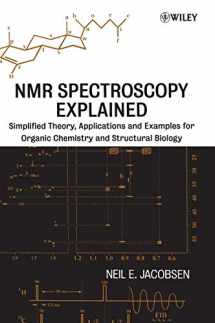
NMR Spectroscopy Explained: Simplified Theory, Applications and Examples for Organic Chemistry and Structural Biology
ISBN-13:
9780471730965
ISBN-10:
0471730963
Edition:
1
Author:
Neil E. Jacobsen
Publication date:
2007
Publisher:
Wiley-Interscience
Format:
Hardcover
688 pages
Category:
Chemistry
,
Earth Sciences
,
Physics
FREE US shipping
Rent
35 days
Due Jun 30, 2024
35 days
from $35.36
USD
Book details
ISBN-13:
9780471730965
ISBN-10:
0471730963
Edition:
1
Author:
Neil E. Jacobsen
Publication date:
2007
Publisher:
Wiley-Interscience
Format:
Hardcover
688 pages
Category:
Chemistry
,
Earth Sciences
,
Physics
Summary
NMR Spectroscopy Explained: Simplified Theory, Applications and Examples for Organic Chemistry and Structural Biology (ISBN-13: 9780471730965 and ISBN-10: 0471730963), written by authors
Neil E. Jacobsen, was published by Wiley-Interscience in 2007.
With an overall rating of 4.0 stars, it's a notable title among other
Chemistry
(Earth Sciences, Physics) books. You can easily purchase or rent NMR Spectroscopy Explained: Simplified Theory, Applications and Examples for Organic Chemistry and Structural Biology (Hardcover, Used) from BooksRun,
along with many other new and used
Chemistry
books
and textbooks.
And, if you're looking to sell your copy, our current buyback offer is $4.02.
Description
NMR Spectroscopy Explained : Simplified Theory, Applications and Examples for Organic Chemistry and Structural Biology provides a fresh, practical guide to NMR for both students and practitioners, in a clearly written and non-mathematical format. It gives the reader an intermediate level theoretical basis for understanding laboratory applications, developing concepts gradually within the context of examples and useful experiments.
- Introduces students to modern NMR as applied to analysis of organic compounds.
- Presents material in a clear, conversational style that is appealing to students.
- Contains comprehensive coverage of how NMR experiments actually work.
- Combines basic ideas with practical implementation of the spectrometer.
- Provides an intermediate level theoretical basis for understanding laboratory experiments.
- Develops concepts gradually within the context of examples and useful experiments.
- Introduces the product operator formalism after introducing the simpler (but limited) vector model.


We would LOVE it if you could help us and other readers by reviewing the book
Book review

Congratulations! We have received your book review.
{user}
{createdAt}
by {truncated_author}



